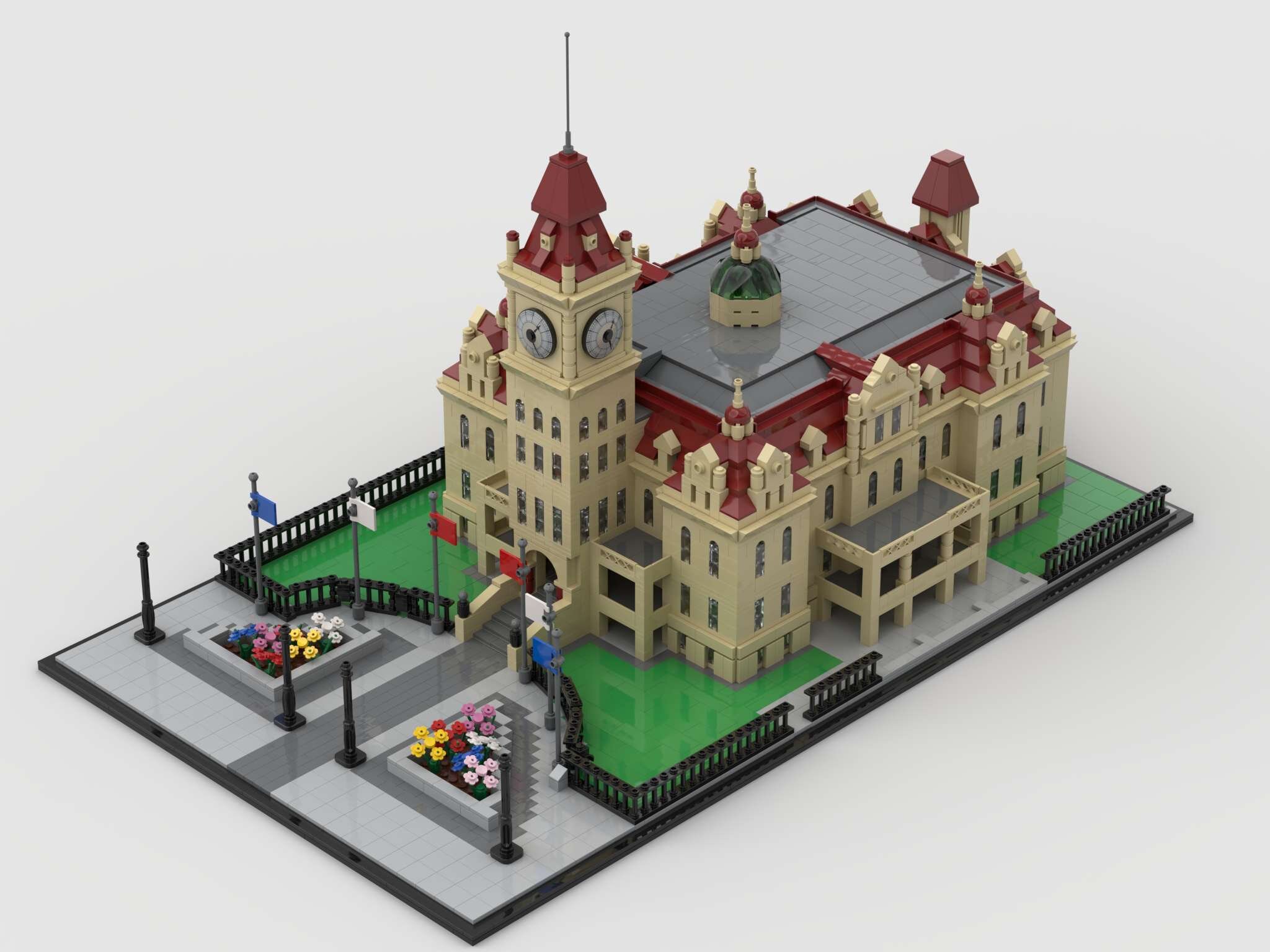Guest Blog: Building a Lego Model of Historic City Hall
Written by Nikolas Marsall-Moritz, MEng, P.Eng.
Project Engineer, Read Jones Christoffersen Ltd.
Chair of the Board, Heritage Calgary
Exterior front and north side view of City Hall, which was officially opened by R.L. Borden on June 26, 1911. Photo: Peel’s Prairie Postcards.
Calgary’s Historic City Hall is one of the more recognizable heritage buildings in the City, and has municipal, provincial and federal recognition. Built between 1907 and 1911, it is a four-storey, sandstone-clad building designed in the Richardsonian Romanesque style. A centrally placed clock tower dominates the structure. The building, located on the eastern edge of downtown, stands adjacent to the modern Municipal Building and comprises part of a complex of municipal administration offices and the seat of government. The property was protected as a Provincial Historic Resource in 1978, designated a National Historic Site in 1984, and protected as a Municipal Historic Resource in 1990.
As part of the project team that worked on the rehabilitation project of Historic City Hall over the last five years, I quickly became interested in the unique architecture and heritage value of the building. This, coupled with my love of Lego, led me to attempt to recreate the building in the little plastic bricks. Back in 2018 I purchased the Lego Architecture Studio set, which contains plain white bricks in a variety of shapes, the idea being that you can use them to build architectural forms. I used this set (and a bit of other random pieces I had) to build “Version 1” of Historic City Hall, which was pretty much just the main face of the building and about half the scale of the later versions.
“Version 1” of the Lego model of Historic City Hall. Photo: Nikolas Marsall-Moritz.
Based on “Version 1”, I determined the pieces I’d need to “scale up” and complete the model, and ordered them online, still all in white. Once the pieces arrived, I built “Version 2”, which turned out quite well.
“Version 2” of the Lego model of Historic City Hall. Photo: Nikolas Marsall-Moritz.
I had been planning on leaving it at that, but the question inevitably came – “Are you going to make a coloured version?” Bowing to the admittedly light twisting of my rubber arm, I used a computer program (Stud.io) to create a colored version using actual available pieces. This necessitated some further tweaks and design changes as certain pieces were not available in the colors I wanted. For instance, the cupula isn’t green, and the front steps aren’t grey. However, I also added in the landscaping, and copied the ”look” of Lego’s Architecture line, of which I am a fan. This became a digital “Version 3”.
“Version 3” of the Lego model of Historic City Hall. Photo: Nikolas Marsall-Moritz.
Armed with this model (and the programs ability to tally the pieces for me!), I went back to the internet to track down even more Lego. Once my latest purchases arrived – with pieces from sellers in the USA, Belgium, Norway and Thailand – I built “Version 4”. With only a few final changes along the way, this turned into the final version – I’m not sure whether I could afford another!
“Version 4” and “Version 2” of Lego City Hall. Version 4 was displayed in the lobby of the Municipal Building while the restoration project was underway.
Some vital statistics of Version 4:
Number of Bricks: 4,252
Unique Bricks: 198, including only one custom engraved brick for the nameplate
Size (w x l x h): 16.4 x 25.8 x 17 inches or 416 x 656 x 432 mm
Weight: 3.67 kg
Hours Invested: I’d rather not think about it!
Until earlier this year, I’ve been honored to be able to display the model in the Municipal Building and, now that it’s back in my possession, also privileged to donate it to Heritage Calgary!
Nikolas Marsall-Moritz is an engineer at Read Jones Christoffersen, specializing in the restoration and repair of structures and building envelope assemblies. Encountering several projects involving historic buildings in the course of his career fuelled an interest in the preservation of these structures. This interest became one of the focuses of his Master’s degree in Engineering from the University of Calgary and has led to a desire to become more involved in local preservation efforts. Nikolas has served as a board member of Heritage Calgary since 2013 and is the Chair.





